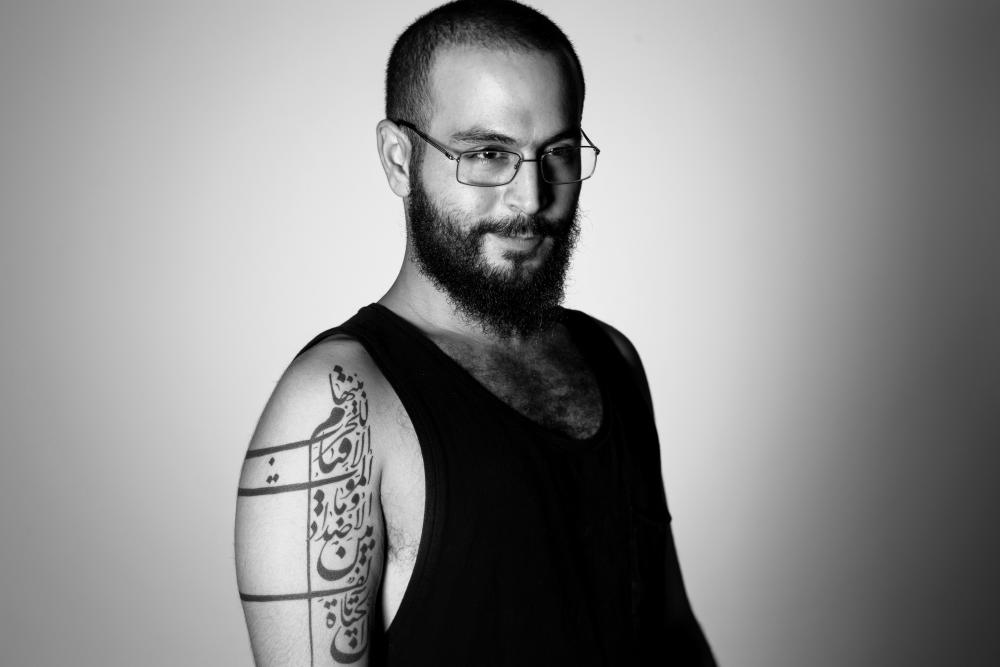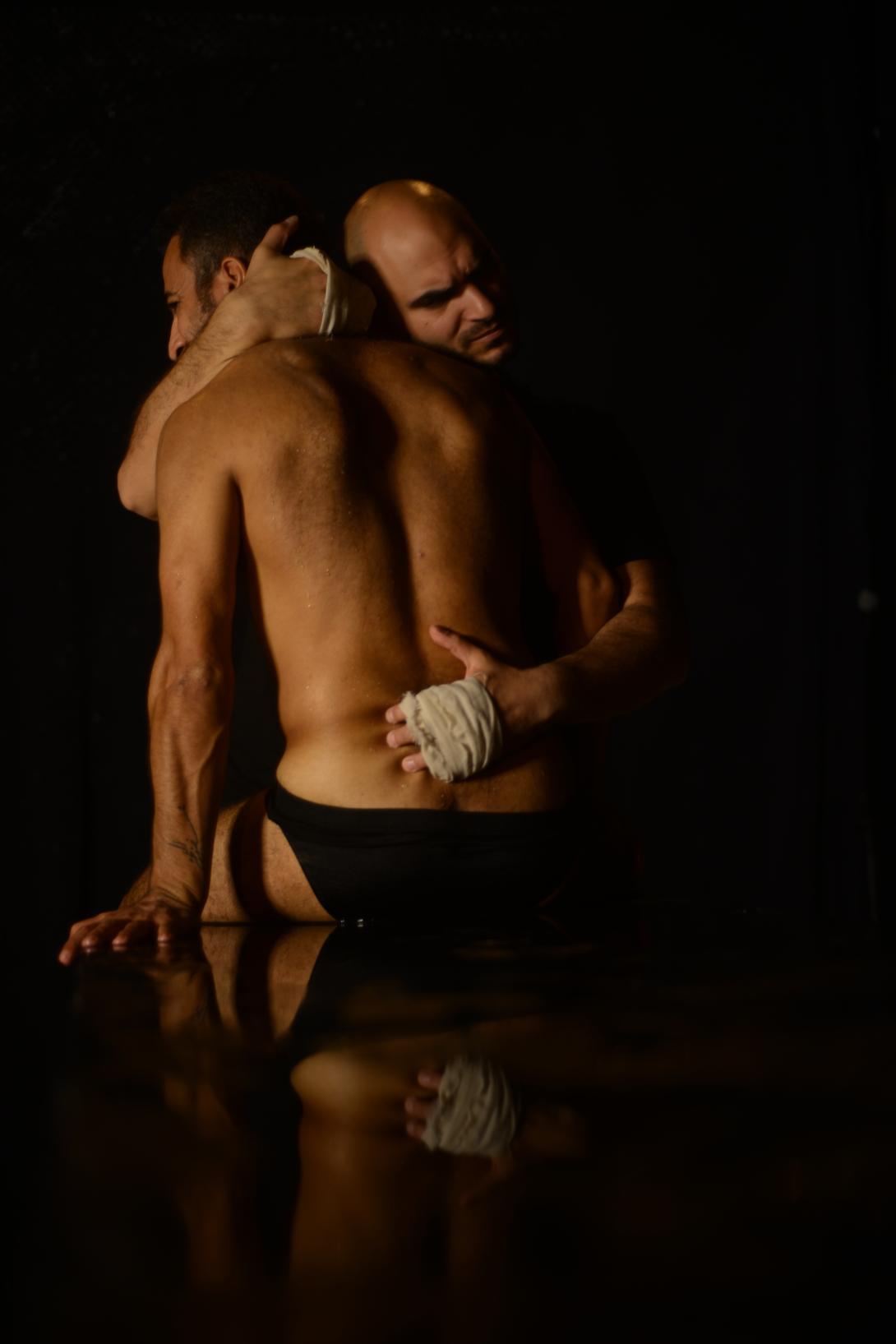Not fighting about my life, but about the meaning of my life
An interview with Bashar Murkus
When we spoke to Bashar Murkus about his latest play, The Museum, he was taking a few days off. It was the perfect moment for an interview, he said, because it offered some distance from the creative process. The young theatre maker is a busy man: since 2011 he has created almost twenty pieces and in 2015 he became the artistic director of the Khashabi Theatre. In The Museum, he stages a dangerous power game: “Violence is not something that belongs to one person, it is part of all human beings.”
The Museum reflects on a terrorist attack. Why did you choose this particular topic?
For The Museum, me and the team chose to research the concept of terrorism or extremism. We had some difficulties with our ways of reflecting on the topic because you easily find yourself talking about it from a very political point of view, using words and descriptions that are defined by the people in power. We deliberately wanted to find a way to talk about terrorism in a different way than the system sees it – ‘a bad thing that people do’. It is a bad thing for sure, but it is wrong to make an enormous distinction between war and terrorism, as the system does. According to us, the only difference is that war involves more money and more power. It has the right to exist because it is initiated by the state.
The Museum stages two figures: the terrorist and the police inspector. Two strong opponents, one would imagine. Can you tell us a bit more about them?
Indeed. We worked on this project for a year and a half. We wanted to find a structure in which we could confront individual terrorism with systemic terrorism, to bring them together onstage. So we linked each of the forms of terrorism to one character. Individual terrorism is represented by someone who has committed a terrorist attack in a modern art museum. He thought that this act would change the world. He chose to attack art and to kill children, children who had been brought to the museum to learn about life. The second character is the inspector. He brings with him all of the system’s presumptions and expectations about how life should be. Our intention in placing two kinds of terrorism side by side is not to attempt to deal desperately with one kind. It is difficult to predict how you might identify with each of the characters, and that is what makes them so interesting. They reunite two opposite ways of seeing life and both are trying to figure out how it should be.
How do the two characters come together?
The play brings together an inspector and a terrorist, depicted here as a prisoner, on the night before the prisoner’s execution. They are alone in a room; nobody can see them. They can do whatever they want in this room. This setting offers them the chance to play very dangerous games. Each of them tests the limits of violence and wickedness in the room that night, exerting their power in every possible way. Violence is clearly not something that belongs to just one person, it is part of all human beings.
In the short description of the piece, the characters stay rather abstract in the sense that they are not identified or contextualized geographically. Is that something that you consciously did to avoid certain debates?
This is how I love theatre the most. I’m not really interested in very personal characters. I’m interested in actors being in the same space as the audience, trying to tell a story, touching on important questions. The main issues should be very human, not connected to one specific place or country. By using basic material, I want to explore how to put it in a structure that can take place in front of the audience.
In this piece, the meeting with the audience is vey powerful. We deal with three different layers of theatre at the same time. We are talking about a terrorist attack, which is actually created to be a movie. People commit attacks to film them. The audience watches it on screens. The attack is a carefully planned production in terms of how it should look, how it should sound, when it should be broadcasted… On the other hand, the state’s execution of the prisoner is also theatre. People should see it and they will film it and broadcast it on TV and in the media. They too have a certain style to show it to the audience. And then there is the piece itself, The Museum, as a third layer. The piece plays with three theatrical creations of situations and we try to find out how they can be brought together on one stage. In this sense, we do not really deal with characters as such, but with what the audience sees and thinks, what the actors are trying to make the audience think or feel. It’s not about Palestine, it’s not about the U.S.A. It’s just about us as people.
You use the museum, which is also a very staged context or space. What does it mean to you? You talked about the museum as a space for learning and history. Why did you specifically choose the museum as the space of an attack?
The step towards the museum seemed a logical one to me: when you have the power and the keys to a museum, you have the power to write history and to write what really happened. I think it’s clever to stage an attack inside a museum. We didn’t want to bring in a crazy person killing people. No, we are talking about someone who has an M.A. in visual arts. He studied, he understands what life is about, what art is about. He thought that in this way, he would be able to change the world. In making this piece, I too hope to change something all over the world. This implies that there is a close connection between art and terrorism. Which is important because I want to be related to the topics that I address in my pieces.
So The Museum is really a piece about how we should see this attack. How to understand it. We usually only hear what the powerful states say on this subject. We hear all these media. We know terrorism in the way that the USA wants us to understand it. And that is false. Of course it is really crazy to kill people like that, but it is also crazy to step into an airplane and just kill thousands of people in one minute. I can’t say that someone who kills fifty children in a museum is more violent than someone sitting in a room in Tel Aviv or anywhere else in Israel and killing people in Gaza just by pressing a button. It’s the same. So let’s talk about the topic from different points of view. That is what we’re trying to do.
The conflict you will be staging in The Museum seems related to a previous piece of yours, New Middle East, which also shows a power relation between someone sentenced to death and a state official, in this case the executioner. Their power relation shifts during the piece. How would you compare these pieces to one another?
The biggest difference between New Middle East and The Museum is what the characters are fighting for. In New Middle East, both characters are fighting to live and stay alive. In The Museum, there is no problem with dying, but they are fighting about the meaning of their death. It’s a huge difference, not fighting about my life but about the meaning of my life. And it generates a very different aesthetic. The new piece is very clean and uses elements of modernism. It visualizes what states can do to kill without a lot of dirt or blood. Just a little injection, calmly, without anybody screaming. Without blood spraying around.
Thinking back on Parallel Time, the piece you made in 2014 with Al-Midan Theatre, which caused the theatre to lose its funding, what is the situation today in Haifa concerning certain narratives?
I currently work at Khashabi theatre, which is an independent Palestinian theatre in Haifa. The theatre consists entirely of independent Palestinian artists. We decided together that we needed a place and a theatre that is independent, that does not receive any Israeli funding, and which is not connected to mainstream culture. And as we are not connected to the state in dealing with our productions, we can produce whatever we want here. In that sense, we are much freer. Here in occupied Palestine, we are happy to be here because this is our land, but there is no space for us in the cultural scene. At the Khashabi theatre, we chose to take our responsibility in the making of our art. It’s our form of resistance and our way to save our identity, ensuring that we can talk to our people and to everyone in the world. It’s crucial to be able to create without any rules or constrictions, without anyone saying ‘you can’t talk like that’. After the Al-Midan Theatre in Haifa closed down, we decided just to break our connections. Now we are dealing with different problems of course, but at least we can create what we want and tour all over the world with it.
A conversation with Bashar Murkus, by Esther Severi & Eva Decaesstecker (Kaaitheater)

